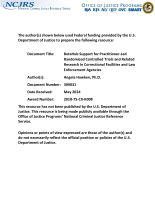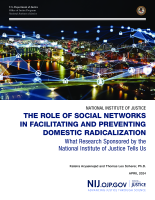Law enforcement
Closing Cases Using Gunshot Residue
Date Published
May 2024
Agencies
NIJ-Sponsored
Closing Cases Using Gunshot Residue
NCJ Number
309020
Date Published
May 2024
Agencies
NIJ-Sponsored
Publication Link
Death Investigation: A Guide for the Scene Investigator, 2024
Date Published
July 2024
Agencies
NIJ
Publication Type
Training (Handbook/Manual)
Macro-Level Influences on Police Decision-Making and Engagement with Victims of Serious Violent Crime: A Narrative Case Study of Two States
Date Published
2022
Agencies
NIJ-Sponsored
Publication Type
Research (Applied/Empirical),
Thesis/Dissertation
FY 2024 Solicitation Overview: Matthew Shepard and James Byrd, Jr. Hate Crimes Program
Date Published
April 2024
Agencies
BJA
Publication Type
Program/Project Description
Binge Drinking, Job Stressors, and Resilience in a Nationally Representative Sample of Law Enforcement Officers
Date Published
2024
Agencies
NIJ-Sponsored
Publication Type
Research (Applied/Empirical)
The Role of Social Networks in Facilitating and Preventing Domestic Radicalization: What Research Sponsored by the National Institute of Justice Tells Us
Date Published
April 2024
Agencies
NIJ
Publication Type
Research (Applied/Empirical)
Philosophies in Community Supervision of Gang-Involved Youth and Adults
Journal
Date Published
March 2024
Agencies
NIJ-Sponsored
Publication Type
Research (Applied/Empirical)
Nevada SafeVoice, Final Summary Overview
Date Published
April 2023
Agencies
NIJ-Sponsored
Publication Type
Program/Project Evaluation
Understanding the Trafficking of Children for the Purposes of Labor in the United States
Date Published
2024
Agencies
NIJ-Sponsored
Publication Type
Research (Applied/Empirical)
The Daunting Task of Strengthening Medical Examiner and Coroner Investigations Across Hundreds of Jurisdictions
Date Published
April 2024
Agencies
NIJ
Publication Type
Research (Applied/Empirical)
The Effect of Occupational Status on Health: Putting the Social in Socioeconomic Status
Journal
Date Published
November 2023
Agencies
NIJ-Sponsored
Publication Type
Research (Applied/Empirical)
A Higher Bar: Institutional Impediments to Hate Crime Prosecution
Journal
Date Published
December 2023
Agencies
NIJ-Sponsored
Publication Type
Research (Applied/Empirical)
Offering Recovery Rather Than Punishment: Implementation of a Law Enforcement-led Pre-arrest Diversion-to-treatment Program for Adults with Substance Use Disorders
Date Published
April 2024
Agencies
NIJ-Sponsored
Publication Type
Research (Applied/Empirical)
Community Perceptions of Contributors and Solutions Related to Neighborhood Violent Crime: A Qualitative Interview Study
Journal
Date Published
January 2024
Agencies
NIJ-Sponsored
Publication Type
Research (Applied/Empirical)











